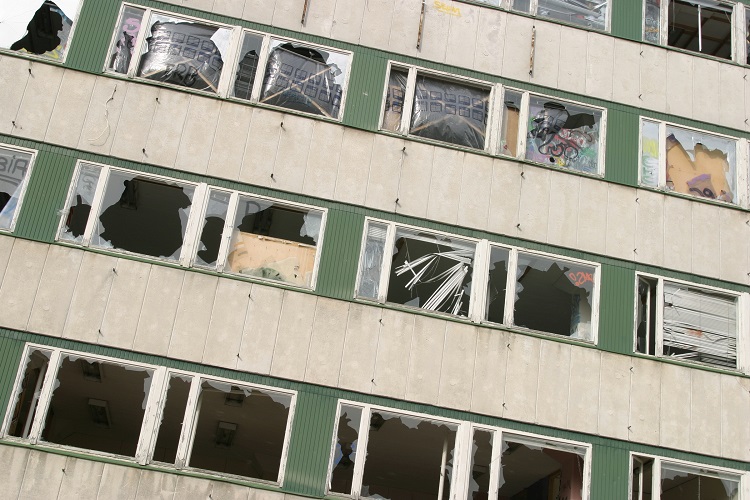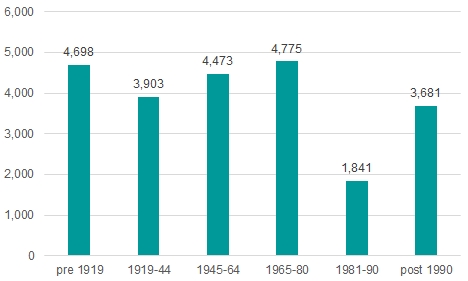Housing stock / building stock

|
| ‘Taking stock’ is a traditional idiom of the English language that derives from the practice of shopkeepers counting and valuing the number of goods in their possession. |
[edit] Housing stock
Housing stock (or dwelling stock) is a term used commonly to refer to the total number of dwellings (houses, bungalows, flats, maisonettes and bedsits) in an area, region or country that are valued as domestic or mixed for the purposes of rating.
Statistics on the housing stock are often closely related to housing supply. According to the UK’s Ministry of Housing, Communities and Local Government, there were 23.9 million dwellings in England on 31 March 2017. Of these, around 606,000 were vacant dwellings. Further information is available here.
Properties forming part of the housing stock can either be occupied or vacant. The total housing stock figure includes properties that may be temporarily uninhabitable but excludes caravans, domestic garages, domestic stores and car parking spaces.
Estimates of total housing stock are usually derived from census data from previous years using the address information for households together with information provided by householders in response to questions in the census. For years that fall between two censuses, the net number of dwellings created since the last census is added to the census figure to arrive at the current total.
Given the UK’s growing population, the housing stock tends to increase each year, even allowing for clearance and redevelopment. However, according to Shelter, successive UK governments have failed to build houses in adequate numbers, and so there is an ongoing housing crisis. In 2015, Lord Kerslake, the chair of the Commission on Affordable Housing in London said “our inability to build enough homes to meet the country’s needs is one of the biggest public policy failures over 50 years.”
For more information see: Housing shortage.
According to the English housing survey 2014 to 2015: housing stock report, the age of the housing stock in England in 2014 was (000's):
For more information see: English housing stock age and The Housing Stock of The United Kingdom.
[edit] Building stock
Building stock is a term that is used to describe the total number of buildings in a country, region, municipal area or estate. It can include dwellings, offices, factories, shops, educational establishments, agricultural buildings and so on.
The Royal Academy of Engineering report 'Engineering a low carbon built environment – The discipline of building engineering physics', published in January 2010 suggested that 80% of the buildings we will be occupying in the UK in 2050 have already been built.
[edit] Related articles on Designing Buildings Wiki
- Affordable housing.
- British post-war mass housing.
- Building.
- Domestic building.
- Dwelling.
- English housing stock age.
- Flat definition.
- Home ownership.
- Household.
- Housebuilder.
- Housing associations.
- Housing shortage.
- Housing standards review.
- Minimum space standards.
- Residential definition.
- Terraced houses and the public realm.
- The Housing Stock of The United Kingdom.
- Types of dwelling.
- What's the condition of your housing stock?
Featured articles and news
RTPI leader to become new CIOB Chief Executive Officer
Dr Victoria Hills MRTPI, FICE to take over after Caroline Gumble’s departure.
Social and affordable housing, a long term plan for delivery
The “Delivering a Decade of Renewal for Social and Affordable Housing” strategy sets out future path.
A change to adoptive architecture
Effects of global weather warming on architectural detailing, material choice and human interaction.
The proposed publicly owned and backed subsidiary of Homes England, to facilitate new homes.
How big is the problem and what can we do to mitigate the effects?
Overheating guidance and tools for building designers
A number of cool guides to help with the heat.
The UK's Modern Industrial Strategy: A 10 year plan
Previous consultation criticism, current key elements and general support with some persisting reservations.
Building Safety Regulator reforms
New roles, new staff and a new fast track service pave the way for a single construction regulator.
Architectural Technologist CPDs and Communications
CIAT CPD… and how you can do it!
Cooling centres and cool spaces
Managing extreme heat in cities by directing the public to places for heat stress relief and water sources.
Winter gardens: A brief history and warm variations
Extending the season with glass in different forms and terms.
Restoring Great Yarmouth's Winter Gardens
Transforming one of the least sustainable constructions imaginable.
Construction Skills Mission Board launch sector drive
Newly formed government and industry collaboration set strategy for recruiting an additional 100,000 construction workers a year.
New Architects Code comes into effect in September 2025
ARB Architects Code of Conduct and Practice available with ongoing consultation regarding guidance.
Welsh Skills Body (Medr) launches ambitious plan
The new skills body brings together funding and regulation of tertiary education and research for the devolved nation.
Paul Gandy FCIOB announced as next CIOB President
Former Tilbury Douglas CEO takes helm.
UK Infrastructure: A 10 Year Strategy. In brief with reactions
With the National Infrastructure and Service Transformation Authority (NISTA).























